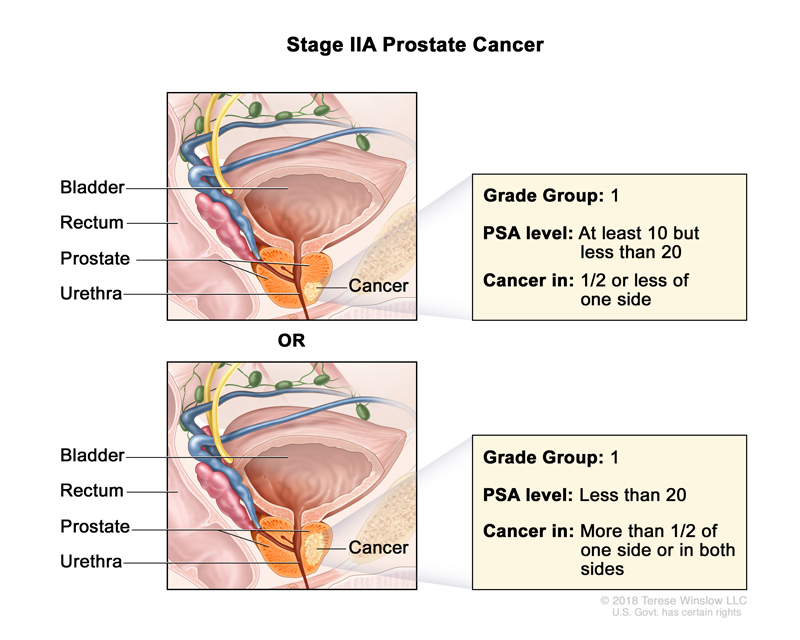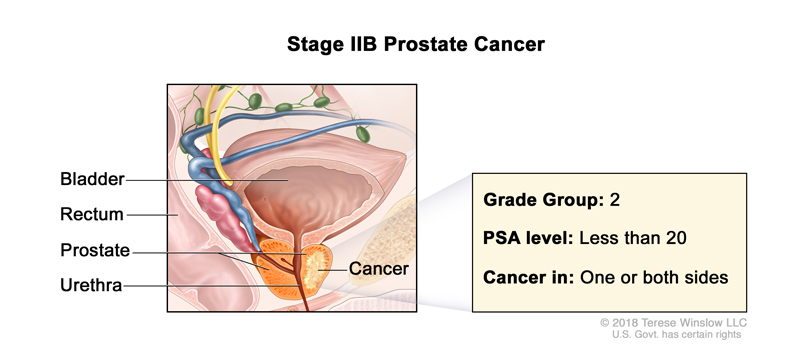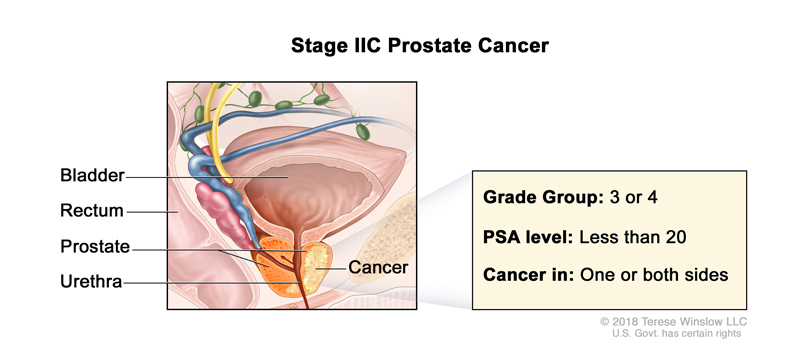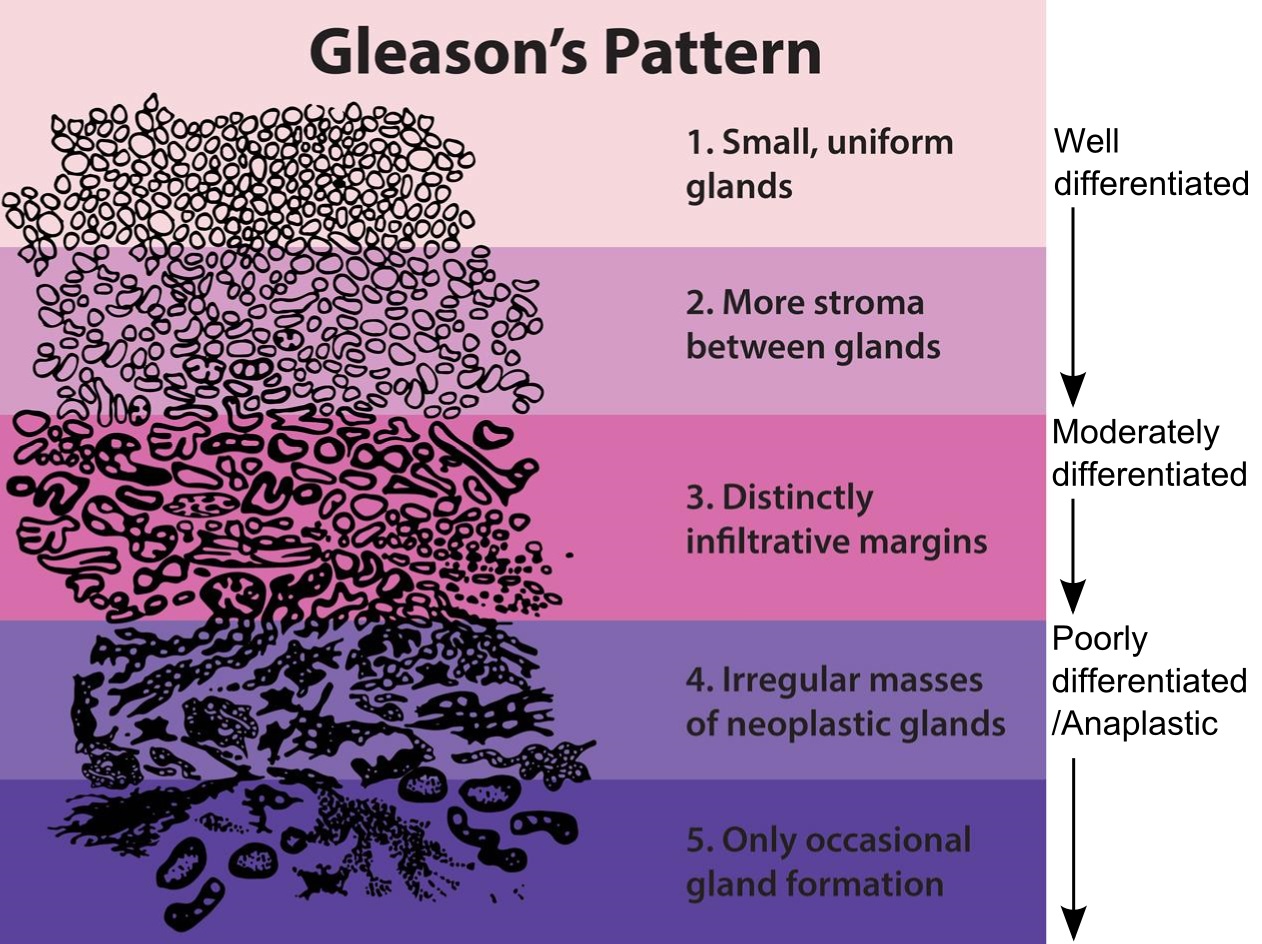Stage 2 Prostate Cancer is divided into 3 stages called 2A, 2B and 2C. Stage 2 Prostate Cancer means the cancer has not spread outside the prostate gland.
Understanding Stage 2 Prostate Cancer will help you partner with your doctors to make the best treatment choice for you. Tap “Watch Now” for an easy-to-understand overview of Stage 2 Prostate Cancer.
- Stage 2A Prostate Cancer
- Stage 2B Prostate Cancer
- Stage 2C Prostate Cancer
- Gleason Score & PSA Tests Explained
Overview
Stage 2A Prostate Cancer means that the tumor affects one half of one side of the prostate or less as shown here in yellow. It has not spread to nearby lymph nodes or any other organ.
What Tests Will I Need and Why?
Blood and Imaging tests are done to understand your general health, confirm your diagnosis and determine your cancer stage.
Tissue Analysis is done to identify the cancer cell type and the Gleason Score, which is critical to finding the best treatment option for you.
A Stage 2A diagnosis means that tissue analysis resulted in a Gleason Score of 6 or less on a scale of 1 to 10. A Gleason Score is used by your doctors to determine the aggressiveness of the cancer.
In addition to a Gleason Score, your doctors will analyze the tissue for your Prostate–Specific Antigen density also referred to as PSA density. A high PSA density predicts if your PSA elevation is due to cancer or other prostate problems. In Stage 2A, your PSA level has been found to be more than 10 but less than 20.
You may also require special Saliva or Blood Analysis to look for specific mutations (actual changes in your body’s DNA), called BRCA1 and BRCA2.
Re-read this summary as needed and then tap, “Compare My Treatment Options Now“. Our unique Comparison Page will help you understand your FDA-approved treatment options including, who can help you pay for your treatment, where and how each is given and what side-effects you may experience.

Overview
Stage 2B Prostate Cancer means that the tumor is affecting one or both sides of the prostate gland as shown here in yellow. It has not spread to nearby lymph nodes or other organs.
What Tests Will I Need and Why?
Blood and Imaging tests are done to understand your general health, confirm your diagnosis and determine your cancer stage.
Tissue Analysis is done to identify the cancer cell type and the Gleason Score, which is critical to finding the best treatment option for you.
A Stage 2B diagnosis means that tissue analysis resulted in a Gleason Score of 7 on a scale of 1 to 10. A Gleason Score is used by your doctors to determine the aggressiveness of the cancer.
In addition to a Gleason Score, your doctors will analyze the tissue for your Prostate–Specific Antigen density also referred to as PSA density. A high PSA density predicts if your PSA elevation is due to cancer or other prostate problems. In Stage 2B, your PSA level has been found to be less than 20, Grade Group 2.
You may also require special Saliva or Blood Analysis to look for specific mutations, actual changes in your body’s DNA, called BRCA1 and BRCA2.
Re-read this summary as needed and then tap, “Compare My Treatment Options Now“. Our unique Comparison Page will help you understand your FDA-approved treatment options including, who can help you pay for your treatment, where and how each is given and what side-effects you may experience.

Overview
Stage 2C Prostate Cancer means that the tumor is located in one or both sides of the prostate as shown here in yellow.
What Tests Will I Need and Why?
Blood and Imaging tests are done to understand your general health, confirm your diagnosis and determine your cancer stage.
Tissue Analysis is done to identify the cancer cell type and the Gleason Score, which is critical to finding the best treatment option for you.
A Stage 2C diagnosis means that tissue analysis resulted in a Gleason Score of 7 or 8 on a scale of 1 to 10. A Gleason Score is used by your doctors to determine the aggressiveness of the cancer.
In addition to a Gleason Score, your doctors will analyze the tissue for your Prostate–Specific Antigen density also referred to as PSA density. A high PSA density predicts if your PSA elevation is due to cancer or other prostate problems. In Stage 2C, your PSA level has been found to be less than 20.
You may also require special Saliva or Blood Analysis to look for specific mutations (actual changes in your body’s DNA), called BRCA1 and BRCA2.
Re-read this summary as needed and then tap, “Compare My Treatment Options Now“. Our unique Comparison Page will help you understand your FDA-approved treatment options including, who can help you pay for your treatment, where and how each is given and what side-effects you may experience.

Gleason Score & PSA Density Explained
A Prostate Cancer diagnosis is based upon the results of staging and two tests requested by your Dr., the Gleason Score and the Prostate-Specific Antigen (PSA).
Gleason Score
Tissue samples removed during a biopsy are used to find out your Gleason Score, a test that describes how aggressive a prostate tumor is. A Gleason Score will range between 2 and 10.
It is made up of 2 grades that range from 1 to 5. A low grade of 1 means that the cells in the tumor look very much like healthy prostate cells. Cells that look completely different to normal cells are assigned a higher score, usually 4 or 5.
- The first grade is given to describe the cells in the largest area of the tumor
- The second grade is given to describe the cells in the second largest area of the tumor.
When these two grades are added together, they give us a Gleason Score between 2 and 10. For example, 3+4 = Gleason Score 7.
PSA Density
Your Dr. also measures PSA Density to help determine the aggressiveness of the prostate cancer. PSA Density is the PSA level, divided by the volume of the prostate gland as measured by ultrasound or MRI.
A high PSA density predicts whether a PSA elevation is due to cancer or other prostate problems.

Recommended Prostate Cancer Videos

Prostate Cancer
An Overview

Understanding Localized Prostate Cancer
An Overview

Prostate Cancer In The Black Community
Brought To You By Black Health Matters

A Diagnosis and Treatment: Localized Prostate Cancer
A Conversation with Dr. John Lynch

Exercise & Prostate Cancer
From Your Friends @ the Oncology Nursing Society

How Cancer Spreads
Metastatic = Advanced
Commonly Searched Questions
Early Stage 2 Prostate Cancer Prevention
While specific prevention strategies for Early Stage 2 Prostate Cancer are not detailed, general recommendations to help reduce the risk of prostate cancer include:
- Healthy Diet: Eat a diet high in fruits, vegetables, and whole grains while limiting high-fat foods, especially those from animal sources.
- Maintain a Healthy Weight: Achieve and maintain a healthy weight through regular physical activity and a balanced diet.
- Avoid Smoking: Do not smoke and avoid exposure to tobacco smoke.
- Avoid Smoking: Do not smoke and avoid exposure to tobacco smoke.
- Regular Check-ups: Discuss with your healthcare provider about the benefits of early prostate cancer screenings, particularly if you are at higher risk due to factors like family history.
These general recommendations focus on reducing overall risk factors and promoting health. For personalized advice, consulting with a healthcare provider is recommended.
Source: PubMed.gov
Early Stage 2 Prostate Cancer Recurrence Rate
The recurrence rate for Early Stage 2 Prostate Cancer varies depending on several factors, including the specific characteristics of the cancer and the treatment used. Generally, the recurrence rate for prostate cancer can range from 20% to 50% over a 10-year period for those diagnosed with early-stage disease. The exact recurrence rate can be influenced by the Gleason score, PSA levels, and whether the cancer has been treated with surgery or radiation. For precise information tailored to individual cases, consulting a healthcare provider is recommended.
Source: PubMed.gov
Early Stage 2 Prostate Cancer Symptoms
Early Stage 2 prostate cancer often does not cause noticeable symptoms. Many men with this stage of cancer are asymptomatic and the disease is typically discovered through routine screenings, such as a prostate-specific antigen (PSA) test or a digital rectal exam (DRE). When symptoms do occur, they may include frequent urination, especially at night; difficulty starting or stopping urination; weak or interrupted urine flow; pain or burning sensation during urination; and blood in the urine or semen. However, these symptoms can also be caused by non-cancerous conditions, so further testing is necessary for a definitive diagnosis.
Source: Effectivehealthcare.ahrq.gov
Early Stage 2 Prostate Cancer Definition
Early Stage 2 prostate cancer is defined as cancer that is still localized within the prostate gland but has grown larger compared to Stage 1. At this stage, the cancer may involve more of the prostate and is detectable through a prostate-specific antigen (PSA) test or a digital rectal exam (DRE). The tumor is still confined to the prostate and has not spread to nearby tissues or other parts of the body. Treatment options typically include surgery, radiation therapy, or active surveillance, depending on various factors including the patient’s overall health and the cancer’s characteristics.
Source: Cancer.ca
Early Stage 2 Prostate Cancer Treatment
Early Stage 2 prostate cancer treatment options are typically aimed at controlling or eliminating the cancer while minimizing side effects. Common treatment approaches include Surgery, Radiation Therapy, Active Surveillance, Hormone Therapy and other treatments.
Now Click Here To Compare Your Latest Treatment Options.
Source: Effectivehealthcare.ahrq.gov
Early Stage 2 Prostate Cancer Survival Rate
According to SEER data, the 5-year relative survival rate for Early Stage 2 Prostate Cancer is nearly 100%. This high survival rate indicates that the prognosis is very favorable when the cancer is localized and has not spread beyond the prostate, making early detection and treatment highly effective.
Source: Cancer.gov






